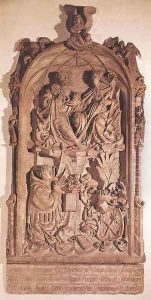Erasmus Grasser Paintings
Erasmus Grasser was a noted German sculptor who was born around 1450, likely in Munich. His exact birthplace is not definitively known, but Munich was the city where he achieved prominence and where he spent the majority of his career. Grasser is often associated with the late Gothic period in Germany, and he was best known for his work in wood, a medium he mastered with exceptional skill.
Grasser's early life and training are not well-documented, but it is presumed that he was apprenticed to a master sculptor as was customary at the time. By the late 15th century, he had become a master in his own right and was receiving commissions from both secular and ecclesiastical patrons. One of his most significant and surviving works is the series of sixteen wooden sculptures known as the 'Morris Dancers', created for the Old Town Hall (Altes Rathaus) in Munich, which were part of a larger decorative program for a festival room. These figures, completed around 1480, are celebrated for their dynamic poses, detailed carving, and expressive character, reflecting the festive dances performed during the period's carnivals.
Throughout his career, Grasser continued to receive important commissions, which included altarpieces and other ecclesiastical sculptures. His style is characterized by a strong sense of naturalism and an attention to detail, which was innovative for his time and suggests an awareness of the evolving Renaissance style. Grasser's work bridged the late Gothic tradition with the early Renaissance, and he contributed to the stylistic transition in southern Germany.
Grasser was also a respected citizen of Munich and held various positions of civic responsibility. He was involved in the local government and guilds, which attests to his integration and importance in the society of his time.
Erasmus Grasser died in 1515 in Munich. His legacy lived on not only through his surviving works but also through his influence on other artists in the region. The historical significance of his work is evidenced by the fact that the 'Morris Dancers' are still on display in Munich, now housed in the Munich City Museum. The meticulous craftsmanship and the vivid portrayal of human figures in Grasser's sculptures continue to draw the admiration of art historians and the public alike, and his contributions to the art of the late Gothic period remain an important part of European art history.
